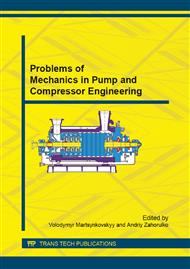[1]
A. Hollander. Stuffing box for refinery pumps - packing vs. mechanical seals. California Oil and Petroleum Industry, (2), (1944).
Google Scholar
[2]
D. Summers-Smith. Laboratory investigation of the performance of a radial face seal. In BHRA, editor, 1st International Conference on Fluid Sealing, number paper D1. BHRA, April (1961).
Google Scholar
[3]
D.F. Denny. Some measurements of fluid pressures between plane parallel thrust surfaces with special reference to radial-face seals. Wear, 4: 64-83, (1961).
DOI: 10.1016/0043-1648(61)90242-3
Google Scholar
[4]
R.K. Flitney and B.S. Nau. Performance testing of mechanical seals. In B.S. Nau, editor, 13th International Conference on Fluid Sealing, pages 441-466, Brugge, Belgium, April, 7-9 1992. BHR Group, Kluwer Academic Publishers.
DOI: 10.1007/978-94-011-2412-6_28
Google Scholar
[5]
H. Lubbinge. On the Lubrication of Mechanical Face Seals. PhD thesis, University of Twente, Netherlands, (1999).
Google Scholar
[6]
I. Green and I. Etsion. Threshold and steady-state response of noncontacting coned-face seals. ASLE Transactions, 28(4): 449-460, (1985).
DOI: 10.1080/05698198508981642
Google Scholar
[7]
K. Ayadi, N. Brunetiere, and B. Tourneie. Mechanical face seals operating in mixed and hydrodynamic regime: Theoretical and experimental comparison. In World Tribology Congress, Torino, Italy, September 8-13 (2013).
Google Scholar
[8]
A.O. Lebeck, M.E. Nygren, S.A. Shirazi, and R. Soulisa. Fluid temperature and film coefficient prediction and measurement in mechanical face seals - experimental results. Tribology Transactions, 41(4): 411-422, October (1998).
DOI: 10.1080/10402009808983766
Google Scholar
[9]
A.O. Lebeck. Mixed lubrication in mechanical face seals with plain faces. IMechE, Part J, Journal of Engineering Tribology, 213(J3): 163-175, (1999).
DOI: 10.1243/1350650991542910
Google Scholar
[10]
C. Minet, N. Brunetiere, and B. Tournerie. A deterministic mixed lubrication model for mechanical seals. Journal of Tribology, 133(4): 042203 (11 pages), October (2011).
DOI: 10.1115/1.4005068
Google Scholar
[11]
A.P. Nyemeck, N. Brunetiere, and B. Tournerie. A multiscale approach to the mixed lubrication regime: Application to mechanical seals. Tribology Letters, 47(3): 417-429, September (2012).
DOI: 10.1007/s11249-012-9997-5
Google Scholar
[12]
A.P. Nyemeck, N. Brunetiere, and B. Tourneie. Parametric study of the behavior of a mechanical face seal operating in mixed and tehd lubrication regimes. In Proceedings of the ASME 2012 11th Biennial Conference On Engineering Systems Design And Analysis, number ESDA2012-82729, Nantes, France, July 2-4 2012. ASME.
DOI: 10.1115/esda2012-82743
Google Scholar
[13]
N. Brunetiere. An analytical approach of the tehd behaviour of mechanical face seals operating in mixed lubrication. IMechE, Part J, Journal of Engineering Tribology, 224(12): 1221-1233, (2010).
DOI: 10.1243/13506501jet831
Google Scholar
[14]
J. A. Greenwood and J. B. P. Williamson. Contact of nominally flat surfaces. Proceedings of the Royal Society (London), A295: 300-319, (1966).
Google Scholar
[15]
N. Brunetiere, B. Tournerie, and C. Minet. On the roughness induced hydrodynamic pressure in mechanical face seals. In 21st International Conference on Fluid Sealing, pages 103-113, Milton Keynes, UK, November 30 - December 1 2011. BHRGroup.
Google Scholar


